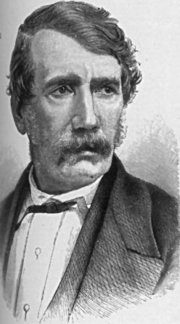David Livingstone
|
|
David Livingstone (March 19, 1813 – May 1, 1873) was a Scottish missionary and explorer of the Victorian era, now best remembered because of his meeting with Henry Morton Stanley which gave rise to the popular quotation, "Dr. Livingstone, I presume."
| Contents |
Early life
Livingstone was born in the village of Blantyre, South Lanarkshire, Scotland and first studied medicine and theology at the University of Glasgow. While working in London, he became attracted by the example of another Scot, Robert Moffat, whose daughter he later married, and joined the London Missionary Society, becoming a minister.
From 1840 he worked in Bechuanaland (now Botswana), but was unable to make inroads into South Africa because of Boer opposition. It was during this time that Livingstone made the one convert that he ever made in Africa. Within 6 months, they had rejected Christianity. He married in 1844, and his wife travelled with him for a brief time at his insistence and over the protests of the Moffats – although she was pregnant – but returned to England with their children.
Discovery of Victoria Falls
David_Livingstone_memorial_at_Victoria_Falls,_Zimbabwe.jpg
In the period 1852–56, he explored the interior, discovering Victoria Falls (which he named after the then monarch, Queen Victoria). Livingstone was one of the first Westerners to make a transcontinental journey across Africa. The purpose of his journey was to open trade routes, whilst accumulating useful information about the African continent. In particular, Livingstone was a proponent of trade and missions to be established in central Africa.
At this time he believed the key to achieving these goals was the navigation of the Zambesi River. He returned to England to try to garner support for his ideas, and to publish a book on his travels. At this time he resigned from the missionary society to which he belonged.
Zambesi Expedition
Livingstone returned to Africa as head of the Zambesi Expedition. While Livingstone was exploring the Zambesi river, the missions sent to central and east Africa at his urgings ended in disaster, with nearly every missionary dying of malaria or other ailments. The Zambesi river turned out to be completely unnavigable past the Kabrabasa rapids, a series of cataracts and rapids that Livingstone had failed to explore on his earlier travels.
The other Westerners, including Livingstone's brother Charles (the one exception being George Rae, an engineer) either died, resigned, or were fired by Livingstone. His wife Mary died on April 29, 1863 of dysentery, but Livingstone continued to explore, eventually returning home in 1864. The Zambesi Expedition was castigated as a failure in many British newspapers of the time, and Livingstone experienced great difficulty in raising funds to further explore Africa.
Source of the Nile
In March 1866, Livingstone returned to Africa, this time to Zanzibar (now part of Tanzania), where he set out to seek the source of the Nile. Richard Francis Burton, John Hanning Speke, and Samuel Baker had earlier (and correctly) identified either Lake Albert or Lake Victoria as the source, but the matter was still debated vigorously. Finding the Lualaba River, which feeds the Congo River, Livingstone decided that this river was in fact the "real" Nile.
Illness and death
He was taken ill, and completely lost contact with the outside world for six years. Only one of his 44 later dispatches made it to Zanzibar. Stanley, who had been sent in a publicity stunt to find him by the New York Herald newspaper in 1869 found Livingstone in the town of Ujiji, on the shores of Lake Tanganyika in 1871. Stanley joined Livingstone, and together they continued exploring the north end of the Tanganyika (the other constituent of the present Tanzania), until Stanley left the next year.
Despite Stanley's urgings, Livingstone was determined not to leave Africa until his mission was complete, and he died there, in Zambia, in 1873 from malaria and internal bleeding caused by bowel obstruction. His body, carried over a thousand miles by his loyal attendants Chuma and Susi, was returned to Britain for burial in Westminster Abbey.

